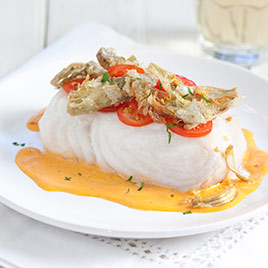
Fillets of meaty white fish like cod, halibut,
sea bass, or snapper work best in this recipe. Just make sure the
fillets are at least 1 inch thick. A neutral oil such as canola can be
substituted for the pure olive oil. The onion half in step 3 is used to
displace the oil; a 4-ounce porcelain ramekin may be used instead. Serve
with couscous or steamed white rice.
Ingredients
Fish
- 4(6-ounce) skinless white fish fillets, 1 inch thick
- Kosher salt
- 4ounces frozen artichoke hearts, thawed, patted dry, and sliced in half lengthwise
- 1tablespoon cornstarch
- 3/4cup olive oil
- 3 garlic cloves, minced
- 1/2 onion, peeled
Vinaigrette
- 4ounces cherry tomatoes
- 1/2small shallot, peeled
- 4teaspoons sherry vinegar
- Kosher salt
- 1/2teaspoon pepper
- 1tablespoon chopped fresh parsley
- 2ounces cherry tomatoes, cut into 1/8-inch-thick rounds
Instructions
- 1. FOR THE FISH: Adjust oven racks to middle and lower-middle positions and heat oven to 250 degrees. Pat fish dry with paper towels and season each fillet with 1/4 teaspoon salt. Let sit at room temperature for 20 minutes.
- 2. Meanwhile, toss artichokes and cornstarch in bowl to coat. Heat 1/2 cup oil in 10-inch nonstick skillet over medium heat until shimmering. Shake excess cornstarch from artichokes and add to skillet; cook, stirring occasionally, until crisp and golden, 2 to 4 minutes. Add garlic and continue to cook until garlic is golden, 30 to 60 seconds. Strain oil through fine-mesh strainer into bowl. Transfer artichokes and garlic to ovenproof paper towel–lined plate and season with salt. Do not wash strainer.
- 3. Return strained oil to skillet and add remaining ¼ cup oil. Place onion half in center of pan. Let oil cool until it registers about 180 degrees, 5 to 8 minutes. Arrange fish fillets, skinned side up, around onion (oil should come roughly halfway up fillets). Spoon a little oil over each fillet, cover skillet, transfer to middle rack, and cook for 15 minutes.
- 4. Remove skillet from oven. Using 2 spatulas, carefully flip fillets. Cover skillet, return to middle rack, and place plate with artichokes and garlic on lower-middle rack. Continue to cook fish until it registers 130 to 135 degrees, 9 to 14 minutes longer. Gently transfer fish to serving platter, reserving 1/2 cup oil, and tent fish loosely with aluminum foil. Turn off oven, leaving plate of artichokes in oven.
- 5. FOR THE VINAIGRETTE: Process whole cherry tomatoes, shallot, vinegar, 3/4 teaspoon salt, and pepper with reserved 1/2 cup fish cooking oil in blender until smooth, 1 to 2 minutes. Add any accumulated fish juice from platter, season with salt to taste, and blend for 10 seconds. Strain sauce through fine-mesh strainer, pressing on solids to extract as much liquid as possible (discard solids).
- 6. To serve, pour vinaigrette around fish. Garnish each fillet with warmed crisped artichokes and garlic, parsley, and tomato rounds. Serve immediately.
Technique
Technique
-
Poaching Fish Out of Water
Oil poaching is not only a foolproof technique for cooking delicate fish but also a seamless way to create a crispy garnish and elegant sauce from the same oil.
-
 FRY GARNISH
FRY GARNISH
When the recipe calls for it, frying artichoke hearts or scallion whites in oil yields a crisp garnish that provides a nice contrast to the fish. -
 COOL HOT OIL
COOL HOT OIL
Pouring 1/4 cup of fresh oil into the strained frying oil helps cool it to a gentle poaching temperature.
-
 DISPLACE OIL
DISPLACE OIL
Adding an onion half displaces the oil, so it comes up higher in the pan—and we can use less of it. -
 TRANSFER TO OVEN
TRANSFER TO OVEN
Poaching in a low oven (rather than on the stove) guarantees more even cooking.
-
 MAKE VINAIGRETTE
MAKE VINAIGRETTE
Using the flavorful poaching oil to create a simple vinaigrette adds brightness.
No comments:
Post a Comment